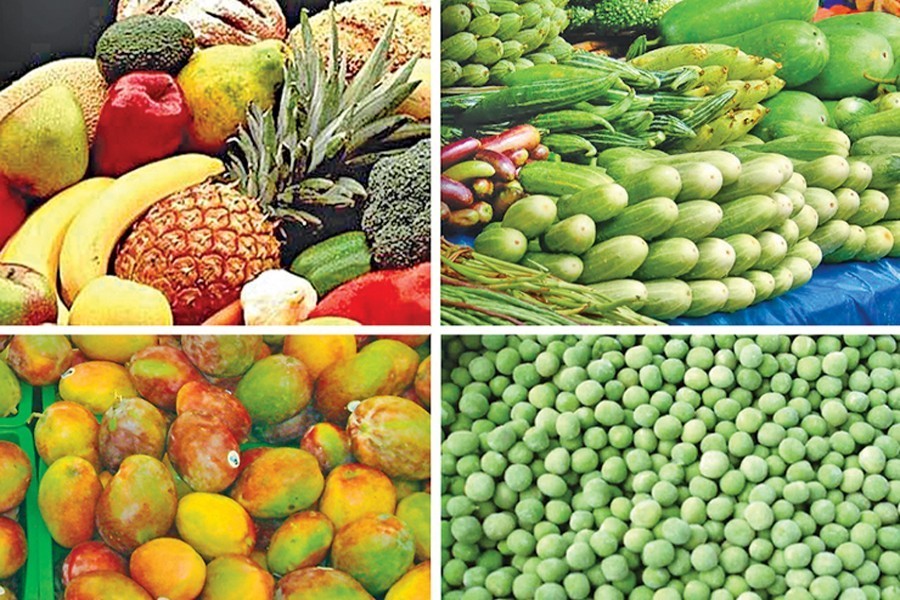Both the electronic and print media nowadays focus on the country's increasing yields of exotic fruits and vegetables. Crop acreages also do not lag behind. It is a pleasant reality that Bangladesh can now take pride in the unique qualities of its soil. It has been amply proved that almost all kinds of fruit, vegetable and crop can be cultivated here. No sooner had the news been made public than a section of overenthusiastic people began estimating the export value of these produce. These foreign fruits and crops do carry export potential. But to attain the level of exportability, the nation has to have patience and wait for the ripe time. It requires space for the nation to master some essential expertise. Moreover, the basic requirements include entrepreneurship and wise advice and guidance.
Thanks to their availability in times of need, the Department of Agricultural Extension (DAE) officials have long earned the trust of Bangladesh farmers. Whenever they require advice on certain crops, they are seen approaching the DAE field-level officials. The latter have hardly been seen reluctant to come up with the necessary counselling. At times, they make extensive tours of the fields of paddy, jute, largely grown vegetable and other crops. Nowadays, a lot of agricultural hands and amateur young farmers are seen turning to growing fruits. Most of them have started orchards of summer fruits. Dominant among them are mangoes and litchis. Those living in the greater Barishal continue to grow guavas of local variety, like their ancestors have done. The local guavas, smaller in size but sweeter, dominate the market for a considerable time during monsoon. Price of the lately popular Thai guavas, also called KazirPeara, declines noticeably during the availability of the native guavas.
Against this backdrop, a lot of exotic fruits have already made inroads into areas growing indigenous fruits for ages. An increasing number of rural agro-entrepreneurs have for some time been making investments in the hitherto-unknown sector. They have targeted growing foreign fruits on the alluvial soil of Bangladesh. Accepting the fruits' successful cultivation as a challenge, a section of them has brought seeds of a number of popular exotic fruits into the country. The fruits are popular with the people of some Southeast Asian countries. To the young growers' amazement, the plants grew smoothly on small patches of land, and bore fruits in time. People acquainted with the ripe fruits back in their countries of origin found little difference between them and those grown on Bangladesh soil. Sold experimentally in small quantities at the Dhaka and other city markets and upon finding positive buyers' response, the farmers expanded the areas of cultivation. It led to increased yields of the fruits.
At the initial phase, the foreign fruit-growers were solely dependent on the local DAE people and horticulturists. Upon realising that they have learnt the nitty-gritty and knowhow of the fruits' large-scale cultivation, they later ventured into the projects all by themselves. Except for advice during crises, they have stopped approaching the fruit-growing experts. The urban fruit markets in the country began witnessing the tentative arrival of locally grown Western strawberries around two decades ago. Now lots of other such fruits keep drawing affluent buyers. Perhaps the most common of foreign fruits now flooding the market are the different types of grapes. Small sour grapes began to be cultivated commercially in parts of Bangladesh in the 1990s. They have recently been joined by the sour-sweet and seedy grapes.
That a large quantity of the citrus fruit 'malta' could be grown in the country has initially carried elements of incredulity. The fruit containers at Dhaka markets filled with Southeast Asian rambutan, Central American dragon fruit, Thai papayas etc stun many. All of them are now commercially grown in Bangladesh. A most fascinating aspect of the episode is few people could have ever thought that the purely European and northern and southern American fruits could ever be grown in this country. But it is now a reality. From longan, avocados, apricots, pears to cross-bred jujube --- fruits of all kinds of taste and aroma continue to beacon young, innovative Bangladeshi farmers. According to senior horticulturists, these exotic fruits will greatly add to the variety of the country's fruit basket.
Despite the Bangladesh soil being alluvial in nature, it is composed of different textures. Those range from sand-laden soft and sticky ones to reddish-hard as found in the country's southwestern region. Of late, the region's soil has been proven ideal for growing quality Gulf dates. A section of Middle East-back youths have been trying relentlessly for around a decade to grow quality dates on the Bangladesh soil. Bangladesh has been known for ages for nutritious and protein-rich mangoes and jackfruits. Exotic fruits like strawberry and others continue to enrich its fruit diversity. Growers of the foreign fruits hope the country can one day earn the capability to export them by ensuring their hazard-free edibility.
Despite the country being a large exporter of vegetables and tropical fruits, its alleged lack of foolproof maintenance of food safety requirements stands as a great impediment to their export. Alongside the indigenous fruits, Bangladesh can expect a wide market for the exotic varieties as well. Thanks to the rich fertility of its soil, the country can look to the prospects for being a source of all kinds of fruits and vegetables. But the required international export standards have to be maintained first. Days may not be far when Bangladesh will emerge as a country growing cassava, a staple food in many tropical countries. The country's soil quality continues to undergo changes. In the last 50 years, many paddy varieties have become extinct to make room for genetically modified high-yield ones.


